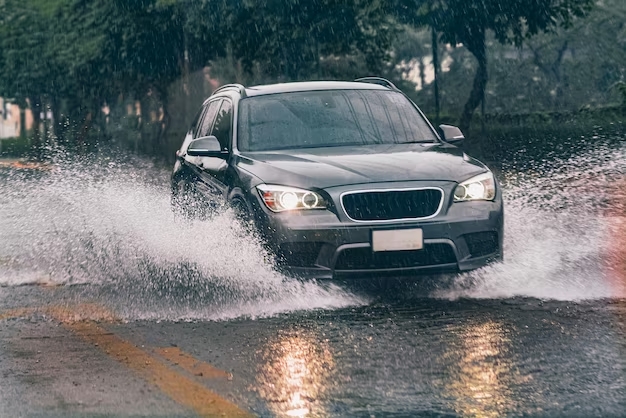By Timothy Albrite
The weatherman earlier this year, cautioned the country to brace for El Nino rains. However, days and weeks passed after the projected start date with little rain and even warmer weather. This led to speculations that the intensity of the rainfall would not be as projected. Kenyans even started making memes and jokes mocking and ridiculing the predictions.
True to the predictions by the Kenya Meteorological Department (KMD), the rains came and are here with us. The current projections state that it may extend to January 2024. As is the norm in our country, rain often disrupts normal operations. It is usually characterized by flooded roads, traffic snarl-ups, and road crash incidents as a result of slippery roads among other inconveniences.
In an enlightening conversation with Fred Majiwa, Head of Programs at St John Ambulance in Kenya, invaluable insights surfaced regarding road safety during extreme weather and the challenges faced especially during the festive season. With his expertise and frontline experience, Majiwa shed light on the perils that often go unnoticed on our roads, especially during the historically treacherous month of December. His wisdom and expertise are encapsulated in the following narrative, offering a beacon of guidance for all road travellers.
The weather forecast has spoken: brace for above-normal rainfall. Even the slightest drizzle threatens to turn roads into slippery traps. Cracks mark the Rift Valley’s Maimahiu route, and in some places, entire roads drown in floods, cutting off passage.
Then there’s rain—the kind that blinds. Driving in such downpours is like navigating blindfolded. Pulling aside is crucial, as driving blind only leads to accidents or breakdowns, further risking lives on the road.
Today’s forecasting tools demand respect. Dismissing predictions, especially with prolonged rainfall on the horizon, is a gamble no road user should take. Just as pilots heed warnings, so should we, for the roads promise adventure but demand respect and preparedness.
To keep you safe on the roads during this period, we bring you Measures to keep you safe in this condition now and in the future.
1. Maintain clear visibility
Clear visibility ensures as the driver, you can see where you are going, obstacles and road conditions to enable you to make the right and safe judgement. It does not stop at that. It also means being able to be seen by other vehicles.
To ensure you have clear visibility:
⁃ Defog your windows; use your car’s defogging system to keep your windshield and windows clear.
⁃ Ensure your wipers are in good condition and working effectively for clear visibility.
⁃ Use fog lights/ headlights to increase your visibility to other motorists and alert them of your presence.
If the intensity of rain is too high and visibility is compromised, pull aside.
2. Slow down
Rain makes the roads slippery, reducing tire grip on the road. This loss of traction increases the chances of skidding or hydroplaning, making it harder to control your vehicle. Slowing down allows tires to better connect and grip the road, thereby enhancing overall control and reducing the risk of losing control.
3. Maintain a safe distance
Among the essential road safety measures during these rains, maintaining a safe following distance is crucial. This rule, a cornerstone of smart driving by FIA, ensures controlled speed adjustments and provides vital time and space for acceleration and deceleration, doubling as an escape route during unexpected road troubles.
“What constitutes a safe following distance?” you might wonder. Here are the top tips to navigate this critical aspect of road safety:
The “3-second rule” takes center stage. In fair weather conditions, maintaining a minimum following distance of three seconds is advised. To measure it, wait until the vehicle in front passes a fixed object and count, one-one-thousand, two-one-thousand, three-one-thousand. If you reach the object before finishing the count, you’re too close!
However, as the rains pour and roads get slick, doubling that following distance becomes imperative. Wet roads mean it takes twice as long to come to a halt, necessitating that extra space. The same caution applies when visibility takes a hit due to fog or darkness.
Handling traffic can be a challenge too. Often, you might be driving at a safe distance, only for another driver to cut in abruptly. Don’t let frustration take over. Instead, hang back until you can establish a safe following distance once again.
And when dealing with tailgaters, those drivers too close behind you, careful handling is crucial.
4. Avoid driving through stagnant water
Kenyans have a brave heart, but sometimes, that confidence is misplaced. The idea that moving water can’t carry a vehicle spells trouble. The reality? Moving water’s strength could carry a house, let alone a truck or a family car. Crossing waters above knee level, be it on foot or behind the wheel, is playing with danger, with slim chances of survival.
Even waters below knee level hide risks. The ground beneath can weaken, bridges might collapse, reptiles lurk, diseases swim, and the risk of electrocution looms. Patience is key; it’s better to wait than risk lives.
To ensure safety, it is crucial to avoid stagnant water. It usually conceals hazards like potholes, debris, and submerged objects. These could damage your vehicle, and tires or render you immobile. The depth of stagnant water is often unpredictable and driving blindly through it could leave the occupants of the vehicle and the vehicle in a hazardous situation.
5. Do not use cruise control
Disable cruise control to have full control over your speed when driving on slick roads. This ensures that as a driver, you can react quickly to different road conditions to ensure safety.
Navigating these crucial road safety measures during El Niño rains can make all the difference between a smooth drive and potential road hazards.
